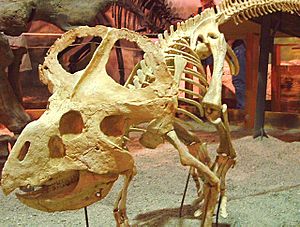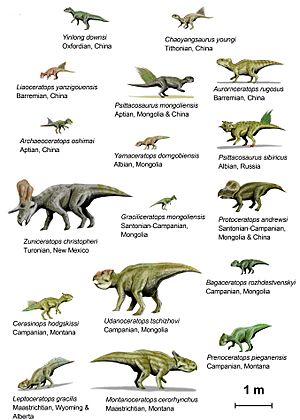Ceratopsia facts for kids
The Ceratopsia are a fascinating group of dinosaurs often called "horned dinosaurs." They were all plant-eaters and had unique beaks, like a parrot. These amazing creatures lived mostly in what is now North America and Asia. They were very successful during the Cretaceous Period, a time long, long ago.


Some of the first horned dinosaurs appeared even earlier, during the Jurassic Period. Early members, like Psittacosaurus, were quite small. They also walked on two legs, meaning they were bipedal.
Later members of this group became much larger. Dinosaurs such as Centrosaurus and Triceratops walked on four legs. This means they were quadrupeds. These bigger horned dinosaurs developed amazing features. They had fancy horns on their faces and a large bony frill around their neck.
The frill likely helped protect their neck. This was important because large, two-legged predators, like Tyrannosaurus, might attack from above. The frill was also probably used for other things. It could have been for showing off to other dinosaurs. It might have helped control body temperature. Also, strong neck and chewing muscles could attach to it.
Horned dinosaurs came in many sizes. The smallest were about 1 meter (3 feet) long and weighed 23 kilograms (50 pounds). The largest ones grew to over 9 meters (30 feet) long. They could weigh as much as 5,400 kg (12,000 pounds). That's like a big truck!
Triceratops is the most well-known horned dinosaur. Many people recognize its three horns and large frill.

Images for kids
-
Agathaumas was one of the first horned dinosaurs discovered.
-
Psittacosaurus, an early type of horned dinosaur.
-
Protoceratops, a well-known horned dinosaur.
-
Styracosaurus, a horned dinosaur with many spikes on its frill.
-
Triceratops, one of the last and largest horned dinosaurs.
-
How Protoceratops grew from a baby to an adult.
See also
 In Spanish: Ceratopsia para niños
In Spanish: Ceratopsia para niños












